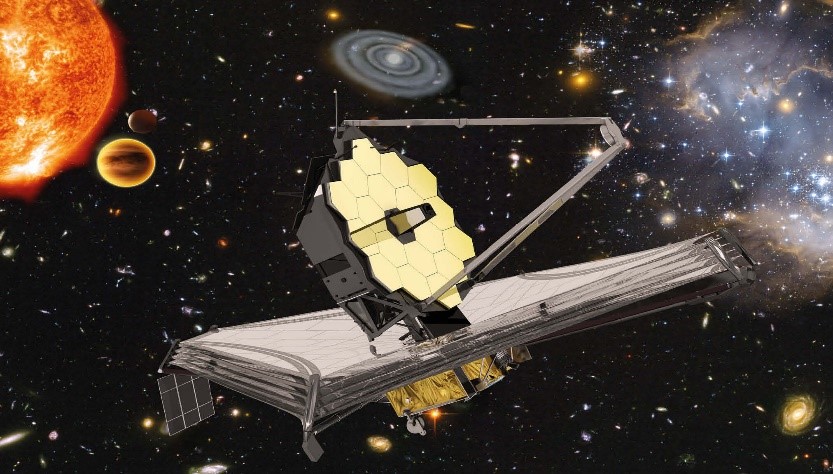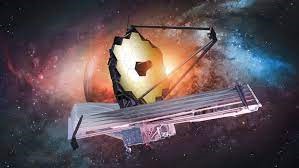Launch, Deployment, and Operations
Launch:
The James Webb Space Telescope (JWST) isn't just a marvel of engineering and a scientific powerhouse—it's also embarking on an incredible journey from Earth to its designated position in space. In this part of the blog series, we'll delve into the intricacies of the JWST's launch, the deployment of its delicate components, and how it will operate to fulfill its ambitious scientific goals.

Figure 1. Launch, Deployment, and Operations
Figure 1. shows The James Webb Space Telescope was launched on an Ariane 5 rocket. The launch vehicle and launch site were part of the European Space Agency's contribution to the mission. The Ariane 5 is one of the world's most reliable launch vehicles and was chosen for a combination of reliability (it was the only launch vehicle that met NASA's requirements for launching a mission like Webb) and for the value it brought via our international partnership.[1]
1. Probing the Early Universe:
The James Webb Space Telescope (JWST) isn't just an engineering marvel; it's a scientific powerhouse poised to transform our understanding of the universe. In this part of the blog series, we'll delve into the specific scientific goals and cutting-edge instruments that make the JWST a revolutionary tool for exploring the cosmos.
1. Launch Preparation:
The JWST's journey begins with its launch aboard an Ariane 5 rocket from the Guiana Space Centre in French Guiana. This choice of launch vehicle is necessary to deliver the telescope's massive size and weight into space. Extensive testing and precautions are taken to ensure that the JWST is securely attached to the rocket and that it can withstand the vibrations, forces, and stresses of launch.
2. Ariane 5 Launch:
The rocket will carry the JWST into space, and once it reaches a safe distance from Earth's atmosphere, the telescope's journey truly begins. The launch is a crucial phase, as any anomalies or issues could jeopardize the entire mission. Once separated from the rocket's upper stage, the JWST will gradually unfurl its sunshield and begin its voyage to the second Lagrange point (L2).
3. Journey to L2:
The second Lagrange point, L2, is a stable position in space where the gravitational forces of the Earth and the Sun balance out. It allows the JWST to maintain a relatively fixed position relative to Earth and the Sun, providing an unobstructed view of the universe. The telescope's journey to L2 takes several weeks, during which its systems are gradually powered up and tested.
For the James Webb Space Telescope to fit into a rocket, it must be folded up. After launch, Webb will deploy during its roughly 30-day, million-mile journey out to the second Lagrange point (L2). This 48-frame flipbook highlights how Webb deploys or unfolds like a transformer once in space. It can be made at home using paper and a binder clip. As you quickly flip through the frames, you can see an animation of how Webb will deploy in space![2]
4. Deployment Ballet:
Arriving at L2 marks the beginning of the intricate deployment sequence. The JWST's sunshield, made up of five layers, must unfold with precision to protect the instruments from the Sun's heat. The telescope's segmented mirror, consisting of 18 hexagonal segments, must unfold and align to form a single, pristine reflective surface. This deployment ballet is a critical phase and requires a delicate choreography of movements.
5. Instrument Calibration:
After successful deployment, the JWST enters a phase of calibration and testing. The instruments are carefully calibrated to ensure their accuracy and performance in the space environment. The telescope's various systems are fine-tuned to optimize its observational capabilities and ensure that the data it captures is of the highest quality.
6. Autonomous Operations:
Once operational, the JWST largely operates autonomously due to its distance from Earth. It uses its onboard software to make decisions about observations, data collection, and communication. The telescope can respond to unexpected events, adjust its orientation, and manage its own resources to maximize its scientific output.
7. Observing the Cosmos:
The primary mission of the JWST is to conduct a wide range of observations, capturing images and data across the infrared spectrum. It will focus on studying distant galaxies, star formation, exoplanets, and other celestial phenomena. The telescope's data will be transmitted back to Earth, where scientists and researchers will analyze it to make groundbreaking discoveries.
8. Legacy and Continued Exploration:
The operational phase of the JWST is expected to last for several years, during which it will contribute to a multitude of scientific advancements and discoveries. Its observations will reshape our understanding of the universe, from the earliest moments after the Big Bang to the characteristics of exoplanets in distant solar systems.
In conclusion, the launch, deployment, and operational phases of the James Webb Space Telescope represent a grand and complex endeavor that involves meticulous planning, engineering excellence, and the use of cutting-edge technology. The telescope's journey from Earth to its perch at L2 and its subsequent scientific operations promise to unveil new cosmic insights, expand our horizons, and ignite the imaginations of generations to come. In the final part of this series, we'll explore the anticipated discoveries and the lasting impact of the JWST on the field of astronomy and beyond.
References:
- https://webb.nasa.gov/content/about/launch.html
- https://webb.nasa.gov/content/features/flipBook.html
Cite this article:
Gokula Nandhini K (2023), James Webb Space Telescope (JWST), AnaTechmaz, pp.4





